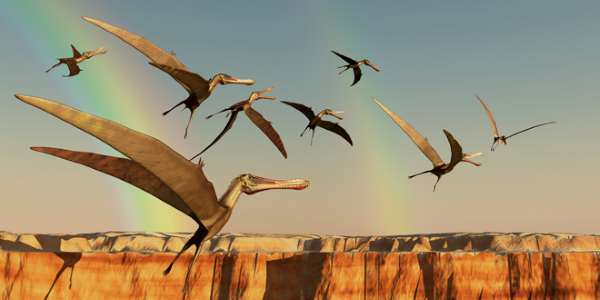The pterodactyl is a generic term which people use to refer to a flying reptile Pterodactylus antiquus or Pteranodon. Interestingly both these flying reptiles were not closely related. The term pterodactyl is not a scientific term. Sometimes the word pterodactyl is used for pterosaurs. Let us use the term ‘pterodactyl’ the same way people use it.
Pterodactyl or pterodactylus antiqqus was a reptile with wings. The wings were probably made of a leathery substance. Scientists discovered the fossils from Germany. The pterodactyl was a carnivorous animal.
Pterodactyl
History
- Cosimo Alessandro Collini, the Italian scientist was the first person to describe pterodactyl. He explained it all in 1784. The scientist discovered the fossil from Bavaria, Germany. Collini did not say anything about the flight of pterodactyl. According to him the pterodactyl might not be the flying reptile. He said there was no indication that pterodactyl could fly like modern bats or even birds.
- Collini suggested that pterodactyl may have been the sea creature. A few other scientists also believed that the pterodactyl might possibly be an aquatic animal.
- Although pterodactyls lived during dinosaur’s age, yet they were not believed to be dinosaurs.

Anatomy
- The pterodactyl had lived 150 million years ago in the Jurassic Period. Some of the remains are also found from Africa.
- Scientists found fossils most of which are of young pterodactyl. It was a small animal with a wingspan reaching 1.04 meters (3 feet 5 inches) in adults.
- The wingspan of a pterodactyl is 3.5 feet (1.06 meters).
- The close relatives of pterodactyl were Aerodactylus, Aurorazhdarcho, Ctenochasma, Gnathosaurus, and Germanodactylus.
- The pteranodon was the largest of the pterosaurs species. It lived during the late Cretaceous period. Pteranodons had a wingspan reaching up to 30 feet. They probably flew like modern-day albatrosses.
- Unlike modern birds female Pteranodons were smaller than the males.
- They had long skulls and many conical teeth. There were 90 teeth in total. They have large opening in the skull.
- In the first year the skull of the pterodactylus grows 15 – 45 mm while in the following year it reaches the maximum length of 55 – 95 mm. Scientists do not know the exact length of a skull of fully mature individual.
- Evidence suggests that the pterodactyl could (and they probably did) learn to fly in just one year.
- Pterodactylus continued to grow all its life like modern crocodiles do.

Behavior and Diet
- The pterodactyl is thought to be diurnal.
- Since the pterodactyl was a carnivorous marine animal it is reasonable to assume that the animal relied on the aquatic prey. The pterodactyl possibly preyed on squid, shellfish, crab, eggs, and lizards.






Leave a Reply